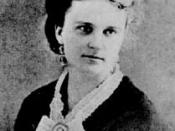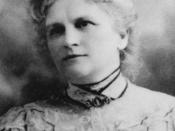Kate Chopin's The Story of an Hour describes the mental processes and behavior of a woman upon discovering the recent news of her husband's death. This story points out the seriousness of some women's oppressive lives in the late 1800's with situational and dramatic irony concerning the life and death of the protagonist Louise Mallard. The contrast between what is predicted to happen and what actually happens compels the reader to look closely to peculiar reactions, unexpected descriptions, and ultimately the ironic joyous death of Mrs. Mallard. These employments of irony reflect the strength of Louise Mallard's need for freedom in an oppressive and overbearing world.
The story begins with the discovery of Brently Mallard's death. After hearing tragic news like this, one would expect the widow to feel most depressed and significantly troubled by this type of event, yet this is not the case with Mrs. Mallard; "She did not hear the story as many women have heard the same" (182).
At first, she is distressed by the initial shock of the news and she, "[weeps] at once with sudden, wild abandonment" (182). Later on she rushes upstairs to her room to find a "new spring life" (182). This form of irony, called situational immediately puzzles the reader and interests him/her to figure out why this woman is so delighted with the news of her husband's death. The weather outside her window in this scene depicts a cheerful, sunny day with singing birds and blue skies, quite unlike the expected gloom and sadness brought on by this kind of discovery. As she becomes aware of what her husband's death actually means, physical changes come over her. "Now her bosom [rises] and [falls] tumultuously", signifying breathing lungs and "her pulses beat fast, and the coursing blood [warms] and [relaxes]...



Good
good use of irony presentation in the essay.
0 out of 0 people found this comment useful.